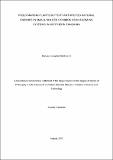| dc.description.abstract | Field margin plants provide habitats and food resources for natural enemies of pests (NEs), but
their potential is poorly understood, particularly in the tropics and on smallholder farms. The
experiments were conducted to test the potential of field margin plants on NEs. Sentinel plants
were developed to collect Aphis fabae and Maruca vitrata parasitoids. Aphidius colemani was
identified as the primary parasitoid of A. fabae. The dominant M. vitrata larval parasitoids were
the Braconidae and Dolichogenidea, while the Platygastridae were the abundant egg
parasitoids. The survey of field margins for plant-NE interactions in bean fields found that NEs
most often interacted with Bidens pilosa (15.4%) and Euphorbia heterophylla (11.3%).
Flowering plant species (Bidens pilosa, Lantana camara, Euphorbia heterophylla and
Ageratum conyzoides) supported NEs out of bean growing season. In cage trials with an aphid-
infested bean plant and a single flowering margin plant, the survival of A. colemani was more
significant in the presence of E. heterophylla than B. pilosa, Tagetes minuta and Hyptis
suaveolens. UV-fluorescent dye was applied to flowers of specific field margin plant species
and NE was sampled from within the bean crop and field margins using sweep-netting and pan-
traps, respectively. Captured insects were examined for the presence of the dye, indicative of a
prior visit to the margin. Lady beetles and assassin bugs were abundant in plots with B. pilosa
margins, hoverflies with T. minuta and Parthenium hysterophorus margins, and lacewings with
T. minuta and B. pilosa margins. NEs were also sampled from high and low plant diversity
bean fields using sweep netting and coloured sticky traps, comparing monocropped and
intercropped farms. Overall, high-plant diversity fields had higher NEs than low-diversity
fields. The field margin had a significantly higher number of NEs than the crop field. However,
marginally higher populations of NEs in intercropping than in monocropping were observed,
although the effect was not significant. To confirm that NE communities on farms predated Aphis
fabae, we extracted and amplified A. fabae DNA from predatory insects. Fourteen lady beetle larvae,
two lacewing larvae, and one assassin bug analyzed were found to contain A. fabae DNA, indicating all
these groups can regulate the significant aphid pest of beans, A. fabae. A. colemani was a parasitoid
that emerged from several non-aphid species collected from the field margins. Overall, NEs
benefitted from field margin plants; those possessing extra floral nectaries had an added
advantage. Thus, smallholder farmers protect the field margins for the added benefit of natural
pest regulation in their fields and thus for food security and enhancing their livelihoods. | en_US |

